Nursing Research Essay: Mental Health in Australia
VerifiedAdded on 2022/11/13
|10
|2927
|399
Essay
AI Summary
This essay provides a comprehensive overview of mental health in Australia, examining the multifaceted nature of mental well-being. It delves into the factors contributing to mental health problems, including biological, psychological, and social influences, while also highlighting early warning signs of mental illness. The essay presents statistical data on the prevalence of mental disorders in Australia, emphasizing the differences across age groups and genders. It explores the structure of mental health services in Australia, detailing both public and private healthcare systems, and discusses the values and principles that underpin these services, such as inclusion, respect, and recovery-oriented care. Furthermore, the essay investigates the critical link between mental health and socioeconomic factors, such as poverty and unemployment, and their impact on mental health outcomes. It addresses the challenges faced by individuals with mental health problems, including discrimination and barriers to employment, and analyzes the violation of human rights experienced by this population. Finally, the essay examines the roles and responsibilities of healthcare professionals, particularly nurses, in providing culturally safe and patient-centered care, and the importance of consumer involvement in mental health service delivery.
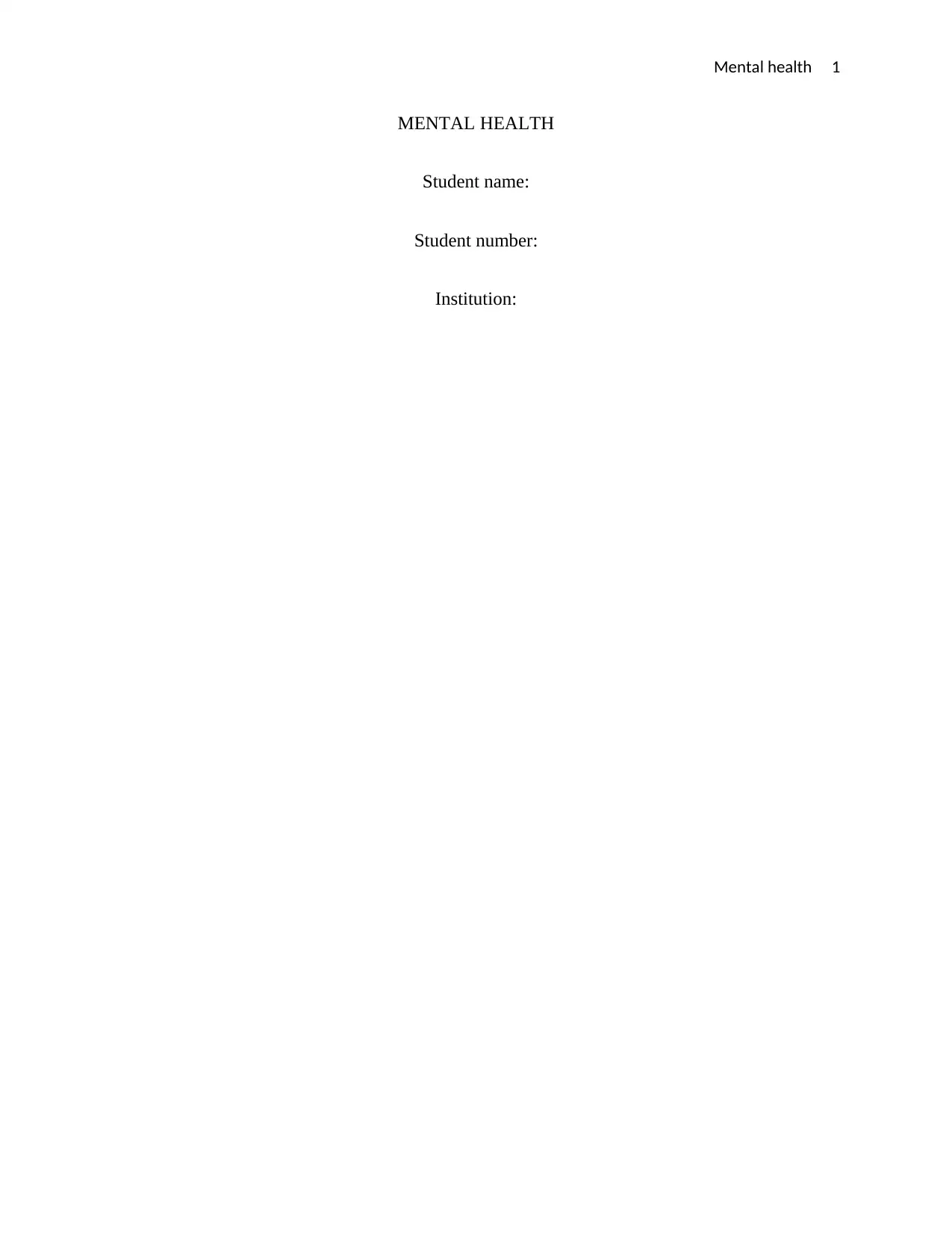
Mental health 1
MENTAL HEALTH
Student name:
Student number:
Institution:
MENTAL HEALTH
Student name:
Student number:
Institution:
Paraphrase This Document
Need a fresh take? Get an instant paraphrase of this document with our AI Paraphraser
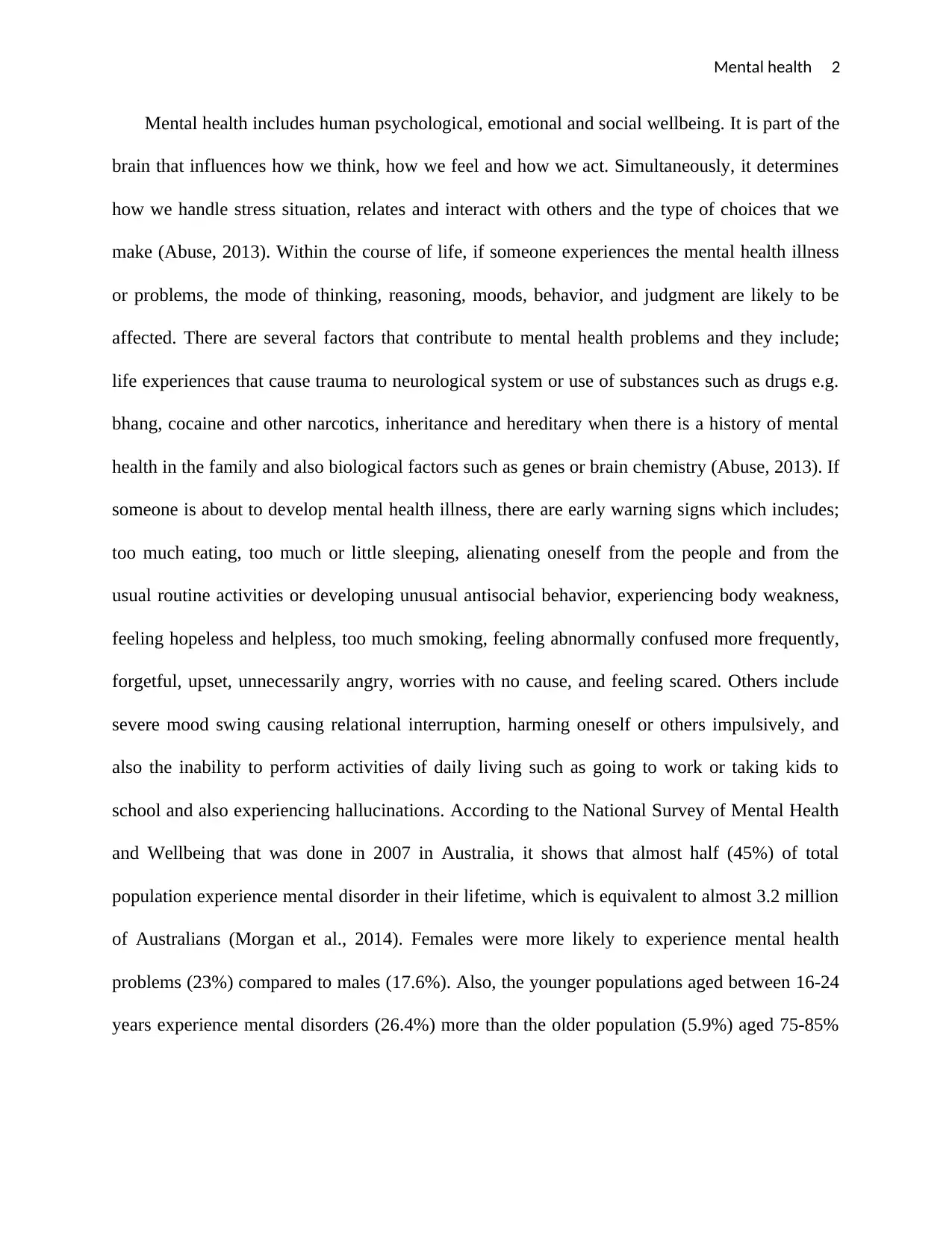
Mental health 2
Mental health includes human psychological, emotional and social wellbeing. It is part of the
brain that influences how we think, how we feel and how we act. Simultaneously, it determines
how we handle stress situation, relates and interact with others and the type of choices that we
make (Abuse, 2013). Within the course of life, if someone experiences the mental health illness
or problems, the mode of thinking, reasoning, moods, behavior, and judgment are likely to be
affected. There are several factors that contribute to mental health problems and they include;
life experiences that cause trauma to neurological system or use of substances such as drugs e.g.
bhang, cocaine and other narcotics, inheritance and hereditary when there is a history of mental
health in the family and also biological factors such as genes or brain chemistry (Abuse, 2013). If
someone is about to develop mental health illness, there are early warning signs which includes;
too much eating, too much or little sleeping, alienating oneself from the people and from the
usual routine activities or developing unusual antisocial behavior, experiencing body weakness,
feeling hopeless and helpless, too much smoking, feeling abnormally confused more frequently,
forgetful, upset, unnecessarily angry, worries with no cause, and feeling scared. Others include
severe mood swing causing relational interruption, harming oneself or others impulsively, and
also the inability to perform activities of daily living such as going to work or taking kids to
school and also experiencing hallucinations. According to the National Survey of Mental Health
and Wellbeing that was done in 2007 in Australia, it shows that almost half (45%) of total
population experience mental disorder in their lifetime, which is equivalent to almost 3.2 million
of Australians (Morgan et al., 2014). Females were more likely to experience mental health
problems (23%) compared to males (17.6%). Also, the younger populations aged between 16-24
years experience mental disorders (26.4%) more than the older population (5.9%) aged 75-85%
Mental health includes human psychological, emotional and social wellbeing. It is part of the
brain that influences how we think, how we feel and how we act. Simultaneously, it determines
how we handle stress situation, relates and interact with others and the type of choices that we
make (Abuse, 2013). Within the course of life, if someone experiences the mental health illness
or problems, the mode of thinking, reasoning, moods, behavior, and judgment are likely to be
affected. There are several factors that contribute to mental health problems and they include;
life experiences that cause trauma to neurological system or use of substances such as drugs e.g.
bhang, cocaine and other narcotics, inheritance and hereditary when there is a history of mental
health in the family and also biological factors such as genes or brain chemistry (Abuse, 2013). If
someone is about to develop mental health illness, there are early warning signs which includes;
too much eating, too much or little sleeping, alienating oneself from the people and from the
usual routine activities or developing unusual antisocial behavior, experiencing body weakness,
feeling hopeless and helpless, too much smoking, feeling abnormally confused more frequently,
forgetful, upset, unnecessarily angry, worries with no cause, and feeling scared. Others include
severe mood swing causing relational interruption, harming oneself or others impulsively, and
also the inability to perform activities of daily living such as going to work or taking kids to
school and also experiencing hallucinations. According to the National Survey of Mental Health
and Wellbeing that was done in 2007 in Australia, it shows that almost half (45%) of total
population experience mental disorder in their lifetime, which is equivalent to almost 3.2 million
of Australians (Morgan et al., 2014). Females were more likely to experience mental health
problems (23%) compared to males (17.6%). Also, the younger populations aged between 16-24
years experience mental disorders (26.4%) more than the older population (5.9%) aged 75-85%
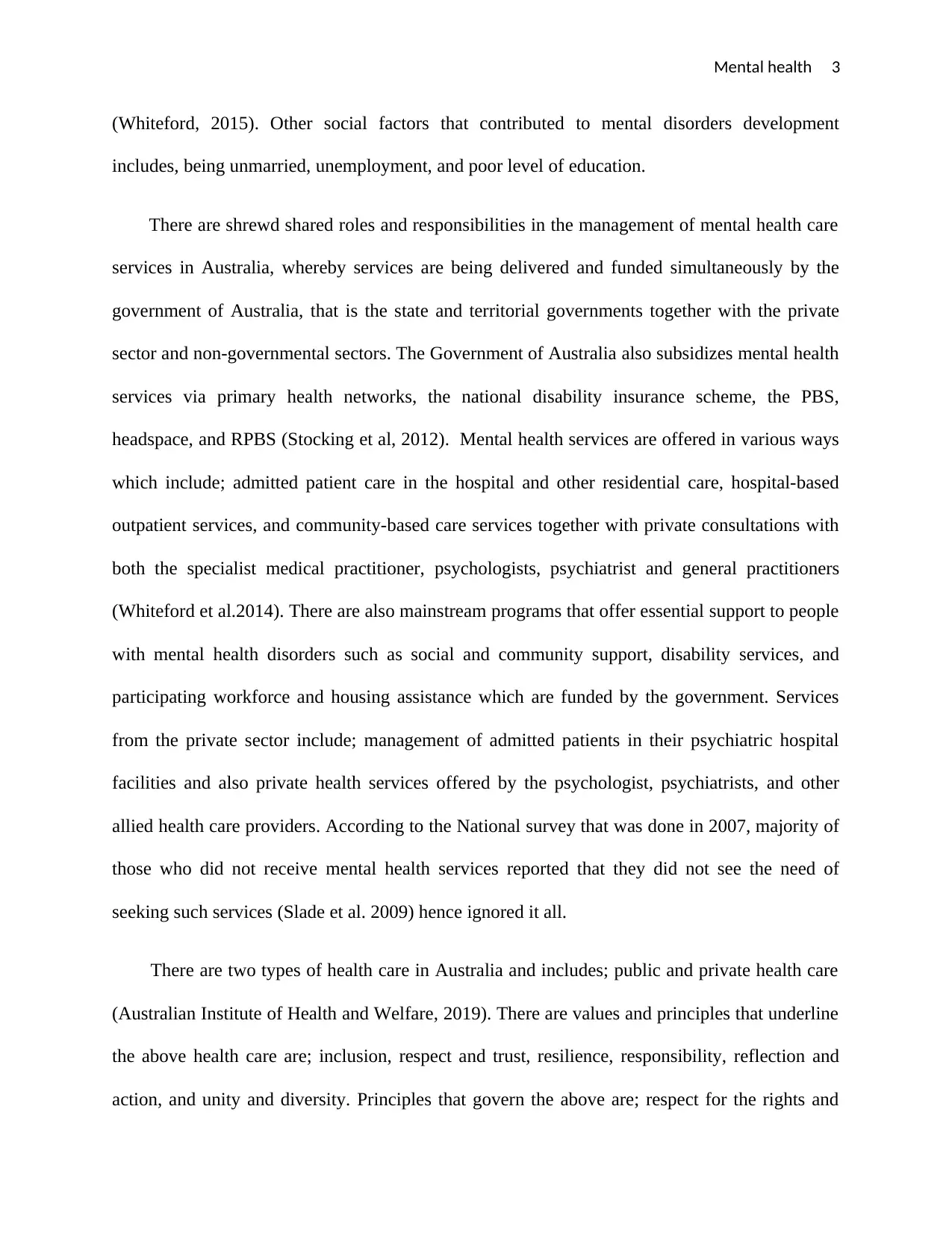
Mental health 3
(Whiteford, 2015). Other social factors that contributed to mental disorders development
includes, being unmarried, unemployment, and poor level of education.
There are shrewd shared roles and responsibilities in the management of mental health care
services in Australia, whereby services are being delivered and funded simultaneously by the
government of Australia, that is the state and territorial governments together with the private
sector and non-governmental sectors. The Government of Australia also subsidizes mental health
services via primary health networks, the national disability insurance scheme, the PBS,
headspace, and RPBS (Stocking et al, 2012). Mental health services are offered in various ways
which include; admitted patient care in the hospital and other residential care, hospital-based
outpatient services, and community-based care services together with private consultations with
both the specialist medical practitioner, psychologists, psychiatrist and general practitioners
(Whiteford et al.2014). There are also mainstream programs that offer essential support to people
with mental health disorders such as social and community support, disability services, and
participating workforce and housing assistance which are funded by the government. Services
from the private sector include; management of admitted patients in their psychiatric hospital
facilities and also private health services offered by the psychologist, psychiatrists, and other
allied health care providers. According to the National survey that was done in 2007, majority of
those who did not receive mental health services reported that they did not see the need of
seeking such services (Slade et al. 2009) hence ignored it all.
There are two types of health care in Australia and includes; public and private health care
(Australian Institute of Health and Welfare, 2019). There are values and principles that underline
the above health care are; inclusion, respect and trust, resilience, responsibility, reflection and
action, and unity and diversity. Principles that govern the above are; respect for the rights and
(Whiteford, 2015). Other social factors that contributed to mental disorders development
includes, being unmarried, unemployment, and poor level of education.
There are shrewd shared roles and responsibilities in the management of mental health care
services in Australia, whereby services are being delivered and funded simultaneously by the
government of Australia, that is the state and territorial governments together with the private
sector and non-governmental sectors. The Government of Australia also subsidizes mental health
services via primary health networks, the national disability insurance scheme, the PBS,
headspace, and RPBS (Stocking et al, 2012). Mental health services are offered in various ways
which include; admitted patient care in the hospital and other residential care, hospital-based
outpatient services, and community-based care services together with private consultations with
both the specialist medical practitioner, psychologists, psychiatrist and general practitioners
(Whiteford et al.2014). There are also mainstream programs that offer essential support to people
with mental health disorders such as social and community support, disability services, and
participating workforce and housing assistance which are funded by the government. Services
from the private sector include; management of admitted patients in their psychiatric hospital
facilities and also private health services offered by the psychologist, psychiatrists, and other
allied health care providers. According to the National survey that was done in 2007, majority of
those who did not receive mental health services reported that they did not see the need of
seeking such services (Slade et al. 2009) hence ignored it all.
There are two types of health care in Australia and includes; public and private health care
(Australian Institute of Health and Welfare, 2019). There are values and principles that underline
the above health care are; inclusion, respect and trust, resilience, responsibility, reflection and
action, and unity and diversity. Principles that govern the above are; respect for the rights and
⊘ This is a preview!⊘
Do you want full access?
Subscribe today to unlock all pages.

Trusted by 1+ million students worldwide
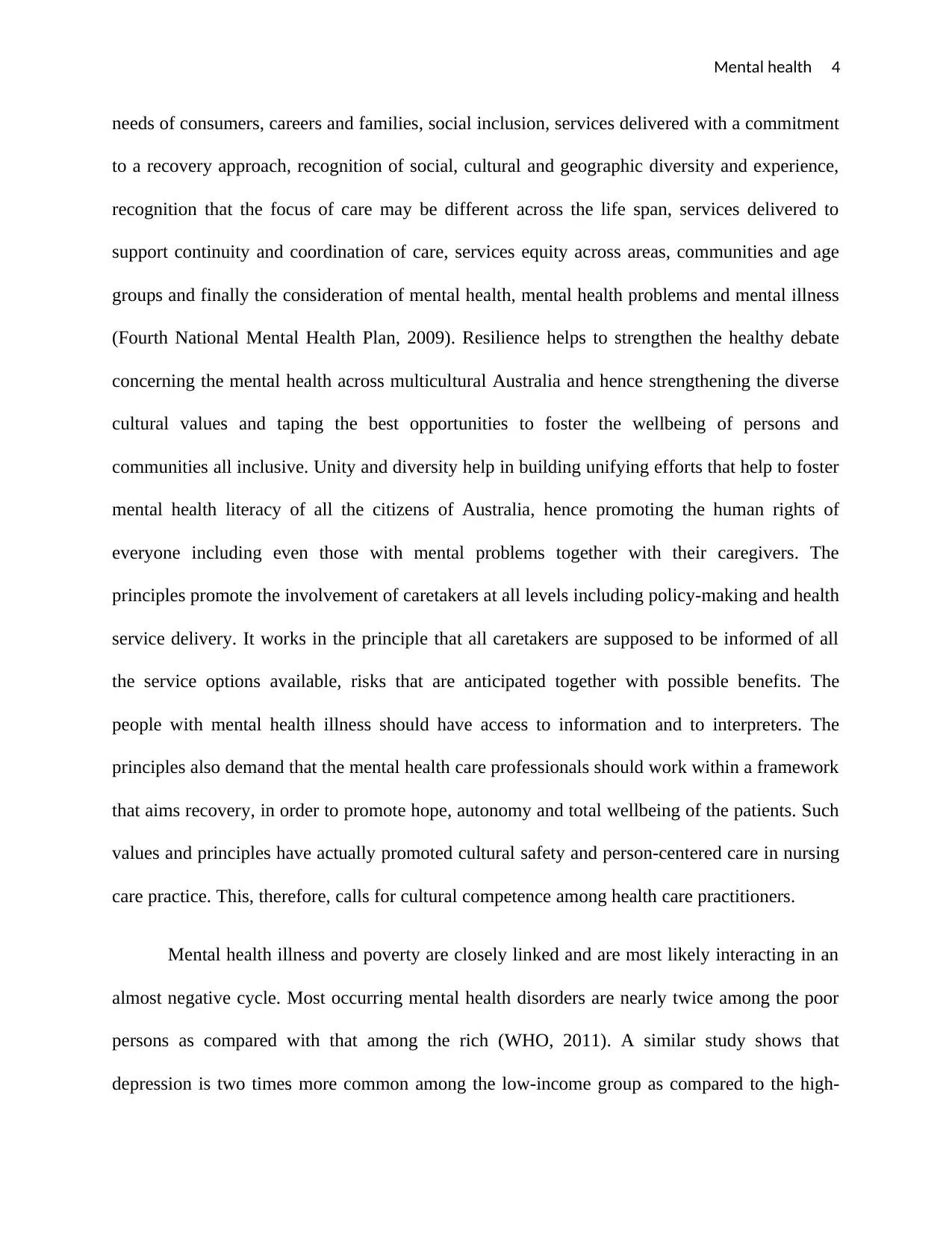
Mental health 4
needs of consumers, careers and families, social inclusion, services delivered with a commitment
to a recovery approach, recognition of social, cultural and geographic diversity and experience,
recognition that the focus of care may be different across the life span, services delivered to
support continuity and coordination of care, services equity across areas, communities and age
groups and finally the consideration of mental health, mental health problems and mental illness
(Fourth National Mental Health Plan, 2009). Resilience helps to strengthen the healthy debate
concerning the mental health across multicultural Australia and hence strengthening the diverse
cultural values and taping the best opportunities to foster the wellbeing of persons and
communities all inclusive. Unity and diversity help in building unifying efforts that help to foster
mental health literacy of all the citizens of Australia, hence promoting the human rights of
everyone including even those with mental problems together with their caregivers. The
principles promote the involvement of caretakers at all levels including policy-making and health
service delivery. It works in the principle that all caretakers are supposed to be informed of all
the service options available, risks that are anticipated together with possible benefits. The
people with mental health illness should have access to information and to interpreters. The
principles also demand that the mental health care professionals should work within a framework
that aims recovery, in order to promote hope, autonomy and total wellbeing of the patients. Such
values and principles have actually promoted cultural safety and person-centered care in nursing
care practice. This, therefore, calls for cultural competence among health care practitioners.
Mental health illness and poverty are closely linked and are most likely interacting in an
almost negative cycle. Most occurring mental health disorders are nearly twice among the poor
persons as compared with that among the rich (WHO, 2011). A similar study shows that
depression is two times more common among the low-income group as compared to the high-
needs of consumers, careers and families, social inclusion, services delivered with a commitment
to a recovery approach, recognition of social, cultural and geographic diversity and experience,
recognition that the focus of care may be different across the life span, services delivered to
support continuity and coordination of care, services equity across areas, communities and age
groups and finally the consideration of mental health, mental health problems and mental illness
(Fourth National Mental Health Plan, 2009). Resilience helps to strengthen the healthy debate
concerning the mental health across multicultural Australia and hence strengthening the diverse
cultural values and taping the best opportunities to foster the wellbeing of persons and
communities all inclusive. Unity and diversity help in building unifying efforts that help to foster
mental health literacy of all the citizens of Australia, hence promoting the human rights of
everyone including even those with mental problems together with their caregivers. The
principles promote the involvement of caretakers at all levels including policy-making and health
service delivery. It works in the principle that all caretakers are supposed to be informed of all
the service options available, risks that are anticipated together with possible benefits. The
people with mental health illness should have access to information and to interpreters. The
principles also demand that the mental health care professionals should work within a framework
that aims recovery, in order to promote hope, autonomy and total wellbeing of the patients. Such
values and principles have actually promoted cultural safety and person-centered care in nursing
care practice. This, therefore, calls for cultural competence among health care practitioners.
Mental health illness and poverty are closely linked and are most likely interacting in an
almost negative cycle. Most occurring mental health disorders are nearly twice among the poor
persons as compared with that among the rich (WHO, 2011). A similar study shows that
depression is two times more common among the low-income group as compared to the high-
Paraphrase This Document
Need a fresh take? Get an instant paraphrase of this document with our AI Paraphraser
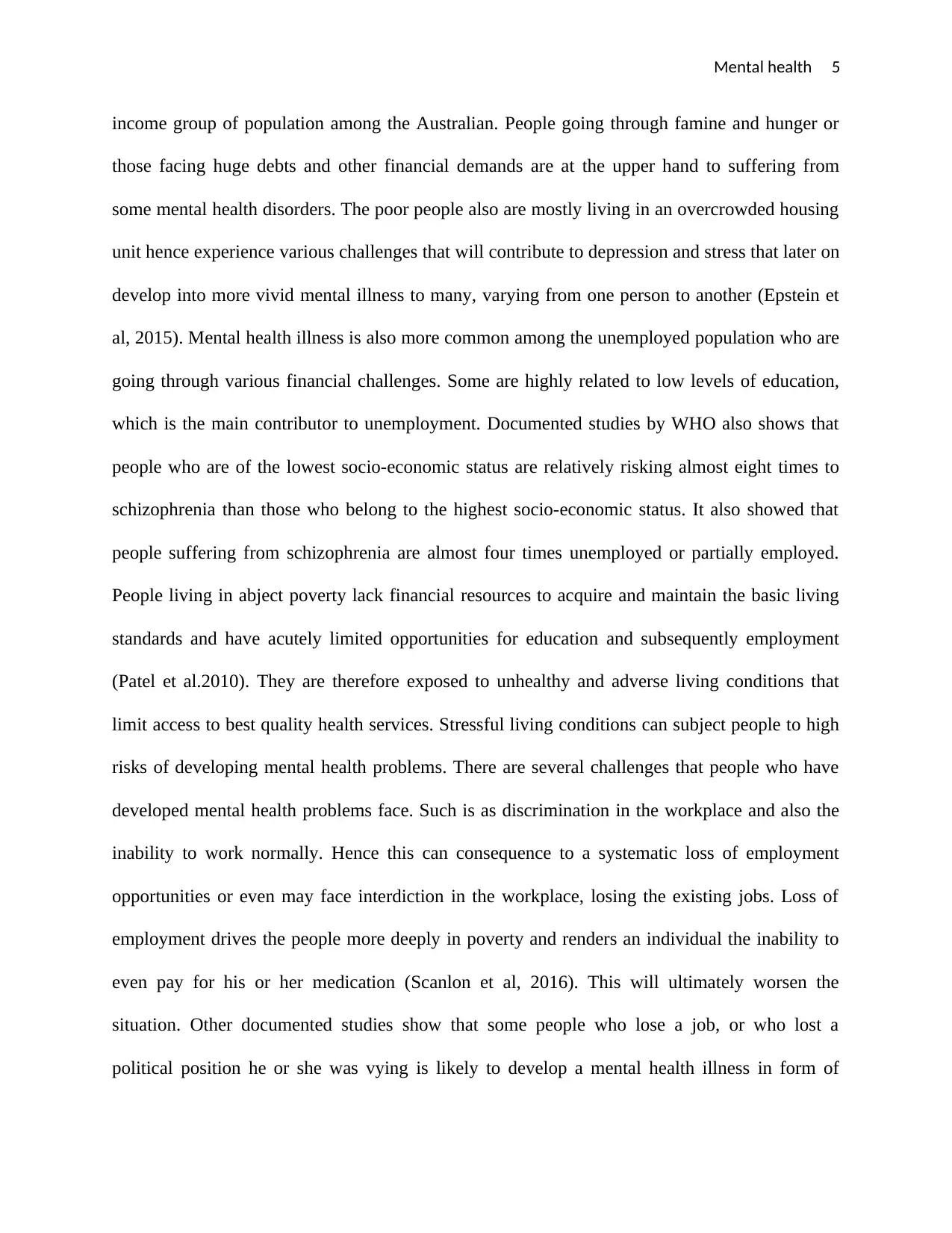
Mental health 5
income group of population among the Australian. People going through famine and hunger or
those facing huge debts and other financial demands are at the upper hand to suffering from
some mental health disorders. The poor people also are mostly living in an overcrowded housing
unit hence experience various challenges that will contribute to depression and stress that later on
develop into more vivid mental illness to many, varying from one person to another (Epstein et
al, 2015). Mental health illness is also more common among the unemployed population who are
going through various financial challenges. Some are highly related to low levels of education,
which is the main contributor to unemployment. Documented studies by WHO also shows that
people who are of the lowest socio-economic status are relatively risking almost eight times to
schizophrenia than those who belong to the highest socio-economic status. It also showed that
people suffering from schizophrenia are almost four times unemployed or partially employed.
People living in abject poverty lack financial resources to acquire and maintain the basic living
standards and have acutely limited opportunities for education and subsequently employment
(Patel et al.2010). They are therefore exposed to unhealthy and adverse living conditions that
limit access to best quality health services. Stressful living conditions can subject people to high
risks of developing mental health problems. There are several challenges that people who have
developed mental health problems face. Such is as discrimination in the workplace and also the
inability to work normally. Hence this can consequence to a systematic loss of employment
opportunities or even may face interdiction in the workplace, losing the existing jobs. Loss of
employment drives the people more deeply in poverty and renders an individual the inability to
even pay for his or her medication (Scanlon et al, 2016). This will ultimately worsen the
situation. Other documented studies show that some people who lose a job, or who lost a
political position he or she was vying is likely to develop a mental health illness in form of
income group of population among the Australian. People going through famine and hunger or
those facing huge debts and other financial demands are at the upper hand to suffering from
some mental health disorders. The poor people also are mostly living in an overcrowded housing
unit hence experience various challenges that will contribute to depression and stress that later on
develop into more vivid mental illness to many, varying from one person to another (Epstein et
al, 2015). Mental health illness is also more common among the unemployed population who are
going through various financial challenges. Some are highly related to low levels of education,
which is the main contributor to unemployment. Documented studies by WHO also shows that
people who are of the lowest socio-economic status are relatively risking almost eight times to
schizophrenia than those who belong to the highest socio-economic status. It also showed that
people suffering from schizophrenia are almost four times unemployed or partially employed.
People living in abject poverty lack financial resources to acquire and maintain the basic living
standards and have acutely limited opportunities for education and subsequently employment
(Patel et al.2010). They are therefore exposed to unhealthy and adverse living conditions that
limit access to best quality health services. Stressful living conditions can subject people to high
risks of developing mental health problems. There are several challenges that people who have
developed mental health problems face. Such is as discrimination in the workplace and also the
inability to work normally. Hence this can consequence to a systematic loss of employment
opportunities or even may face interdiction in the workplace, losing the existing jobs. Loss of
employment drives the people more deeply in poverty and renders an individual the inability to
even pay for his or her medication (Scanlon et al, 2016). This will ultimately worsen the
situation. Other documented studies show that some people who lose a job, or who lost a
political position he or she was vying is likely to develop a mental health illness in form of
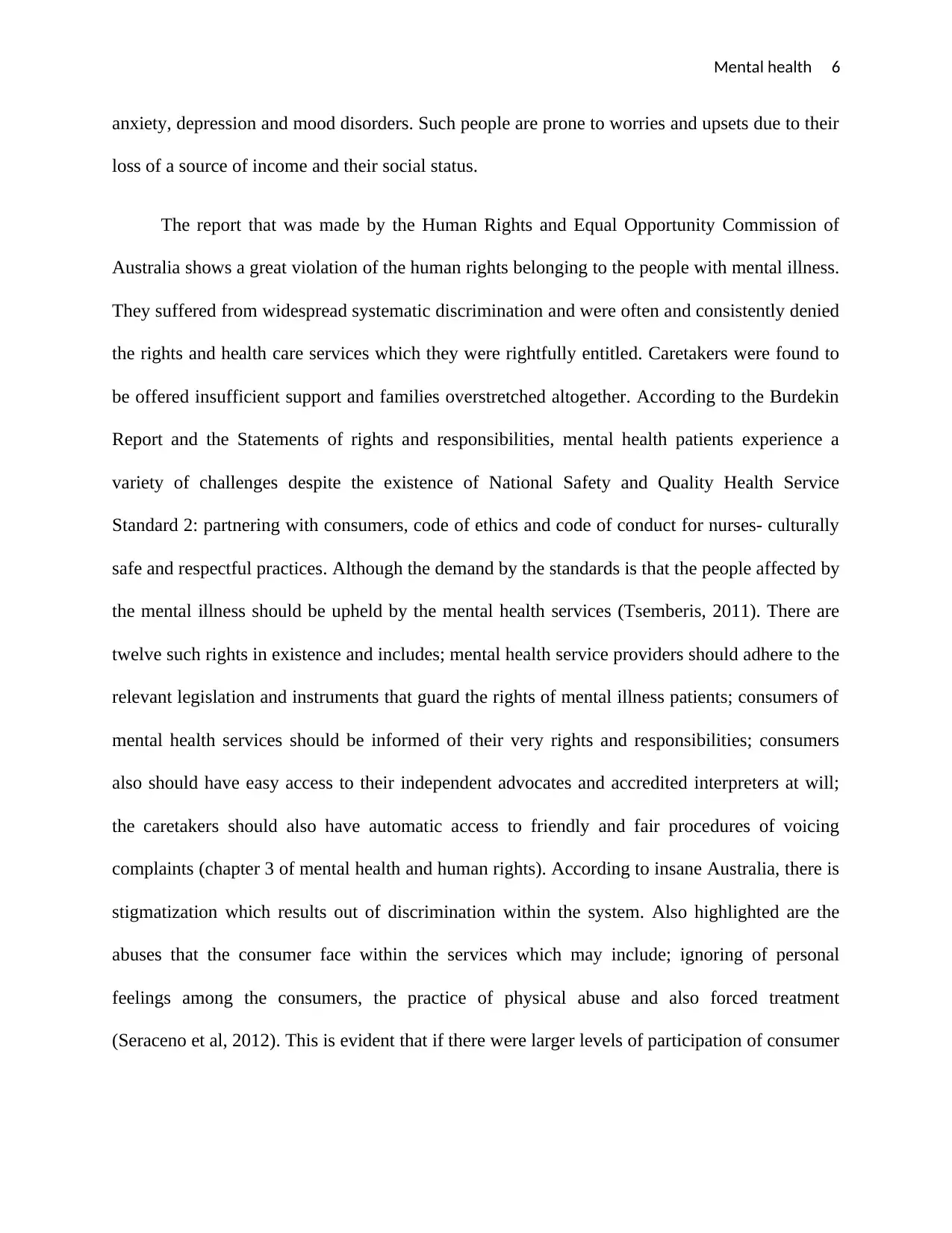
Mental health 6
anxiety, depression and mood disorders. Such people are prone to worries and upsets due to their
loss of a source of income and their social status.
The report that was made by the Human Rights and Equal Opportunity Commission of
Australia shows a great violation of the human rights belonging to the people with mental illness.
They suffered from widespread systematic discrimination and were often and consistently denied
the rights and health care services which they were rightfully entitled. Caretakers were found to
be offered insufficient support and families overstretched altogether. According to the Burdekin
Report and the Statements of rights and responsibilities, mental health patients experience a
variety of challenges despite the existence of National Safety and Quality Health Service
Standard 2: partnering with consumers, code of ethics and code of conduct for nurses- culturally
safe and respectful practices. Although the demand by the standards is that the people affected by
the mental illness should be upheld by the mental health services (Tsemberis, 2011). There are
twelve such rights in existence and includes; mental health service providers should adhere to the
relevant legislation and instruments that guard the rights of mental illness patients; consumers of
mental health services should be informed of their very rights and responsibilities; consumers
also should have easy access to their independent advocates and accredited interpreters at will;
the caretakers should also have automatic access to friendly and fair procedures of voicing
complaints (chapter 3 of mental health and human rights). According to insane Australia, there is
stigmatization which results out of discrimination within the system. Also highlighted are the
abuses that the consumer face within the services which may include; ignoring of personal
feelings among the consumers, the practice of physical abuse and also forced treatment
(Seraceno et al, 2012). This is evident that if there were larger levels of participation of consumer
anxiety, depression and mood disorders. Such people are prone to worries and upsets due to their
loss of a source of income and their social status.
The report that was made by the Human Rights and Equal Opportunity Commission of
Australia shows a great violation of the human rights belonging to the people with mental illness.
They suffered from widespread systematic discrimination and were often and consistently denied
the rights and health care services which they were rightfully entitled. Caretakers were found to
be offered insufficient support and families overstretched altogether. According to the Burdekin
Report and the Statements of rights and responsibilities, mental health patients experience a
variety of challenges despite the existence of National Safety and Quality Health Service
Standard 2: partnering with consumers, code of ethics and code of conduct for nurses- culturally
safe and respectful practices. Although the demand by the standards is that the people affected by
the mental illness should be upheld by the mental health services (Tsemberis, 2011). There are
twelve such rights in existence and includes; mental health service providers should adhere to the
relevant legislation and instruments that guard the rights of mental illness patients; consumers of
mental health services should be informed of their very rights and responsibilities; consumers
also should have easy access to their independent advocates and accredited interpreters at will;
the caretakers should also have automatic access to friendly and fair procedures of voicing
complaints (chapter 3 of mental health and human rights). According to insane Australia, there is
stigmatization which results out of discrimination within the system. Also highlighted are the
abuses that the consumer face within the services which may include; ignoring of personal
feelings among the consumers, the practice of physical abuse and also forced treatment
(Seraceno et al, 2012). This is evident that if there were larger levels of participation of consumer
⊘ This is a preview!⊘
Do you want full access?
Subscribe today to unlock all pages.

Trusted by 1+ million students worldwide
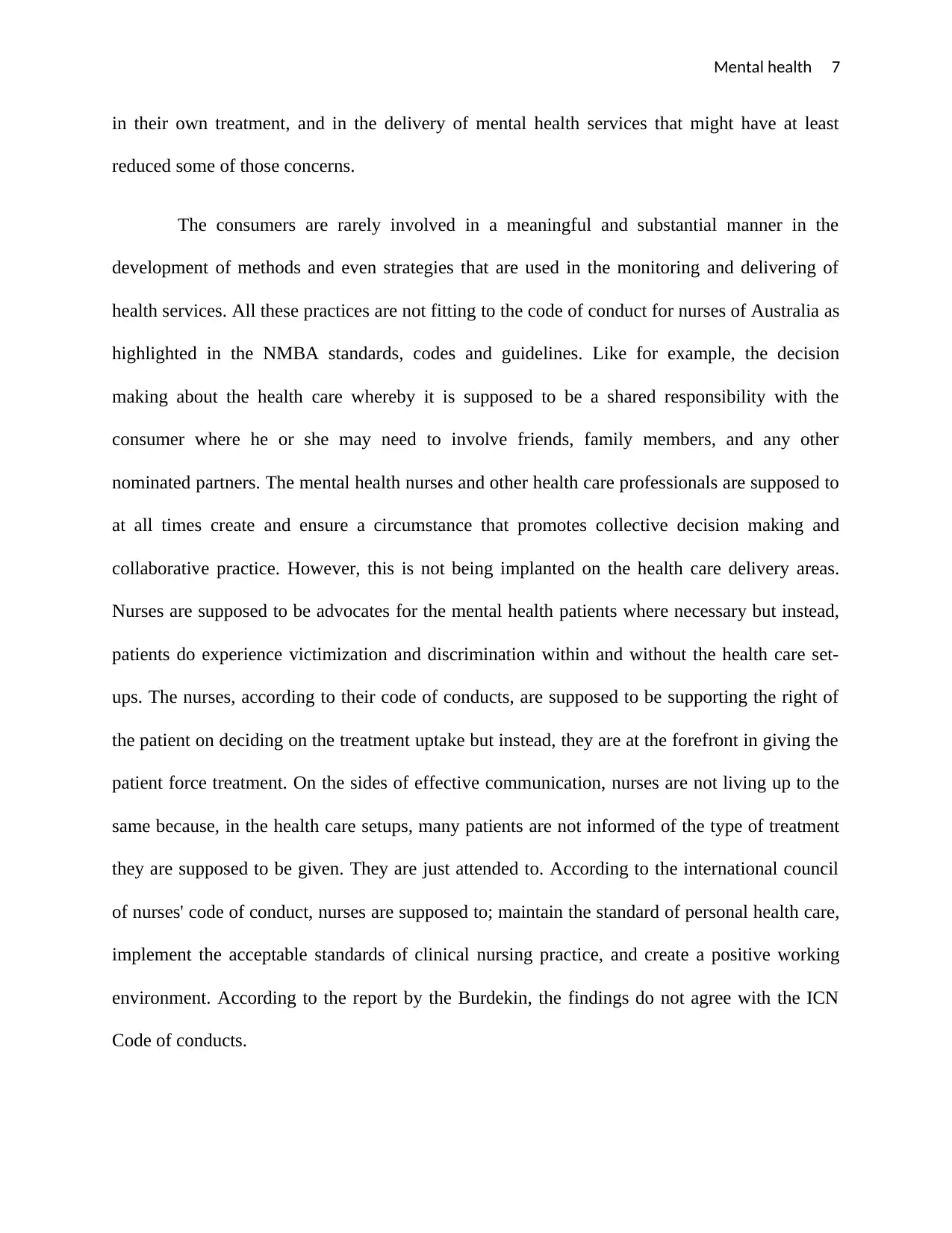
Mental health 7
in their own treatment, and in the delivery of mental health services that might have at least
reduced some of those concerns.
The consumers are rarely involved in a meaningful and substantial manner in the
development of methods and even strategies that are used in the monitoring and delivering of
health services. All these practices are not fitting to the code of conduct for nurses of Australia as
highlighted in the NMBA standards, codes and guidelines. Like for example, the decision
making about the health care whereby it is supposed to be a shared responsibility with the
consumer where he or she may need to involve friends, family members, and any other
nominated partners. The mental health nurses and other health care professionals are supposed to
at all times create and ensure a circumstance that promotes collective decision making and
collaborative practice. However, this is not being implanted on the health care delivery areas.
Nurses are supposed to be advocates for the mental health patients where necessary but instead,
patients do experience victimization and discrimination within and without the health care set-
ups. The nurses, according to their code of conducts, are supposed to be supporting the right of
the patient on deciding on the treatment uptake but instead, they are at the forefront in giving the
patient force treatment. On the sides of effective communication, nurses are not living up to the
same because, in the health care setups, many patients are not informed of the type of treatment
they are supposed to be given. They are just attended to. According to the international council
of nurses' code of conduct, nurses are supposed to; maintain the standard of personal health care,
implement the acceptable standards of clinical nursing practice, and create a positive working
environment. According to the report by the Burdekin, the findings do not agree with the ICN
Code of conducts.
in their own treatment, and in the delivery of mental health services that might have at least
reduced some of those concerns.
The consumers are rarely involved in a meaningful and substantial manner in the
development of methods and even strategies that are used in the monitoring and delivering of
health services. All these practices are not fitting to the code of conduct for nurses of Australia as
highlighted in the NMBA standards, codes and guidelines. Like for example, the decision
making about the health care whereby it is supposed to be a shared responsibility with the
consumer where he or she may need to involve friends, family members, and any other
nominated partners. The mental health nurses and other health care professionals are supposed to
at all times create and ensure a circumstance that promotes collective decision making and
collaborative practice. However, this is not being implanted on the health care delivery areas.
Nurses are supposed to be advocates for the mental health patients where necessary but instead,
patients do experience victimization and discrimination within and without the health care set-
ups. The nurses, according to their code of conducts, are supposed to be supporting the right of
the patient on deciding on the treatment uptake but instead, they are at the forefront in giving the
patient force treatment. On the sides of effective communication, nurses are not living up to the
same because, in the health care setups, many patients are not informed of the type of treatment
they are supposed to be given. They are just attended to. According to the international council
of nurses' code of conduct, nurses are supposed to; maintain the standard of personal health care,
implement the acceptable standards of clinical nursing practice, and create a positive working
environment. According to the report by the Burdekin, the findings do not agree with the ICN
Code of conducts.
Paraphrase This Document
Need a fresh take? Get an instant paraphrase of this document with our AI Paraphraser
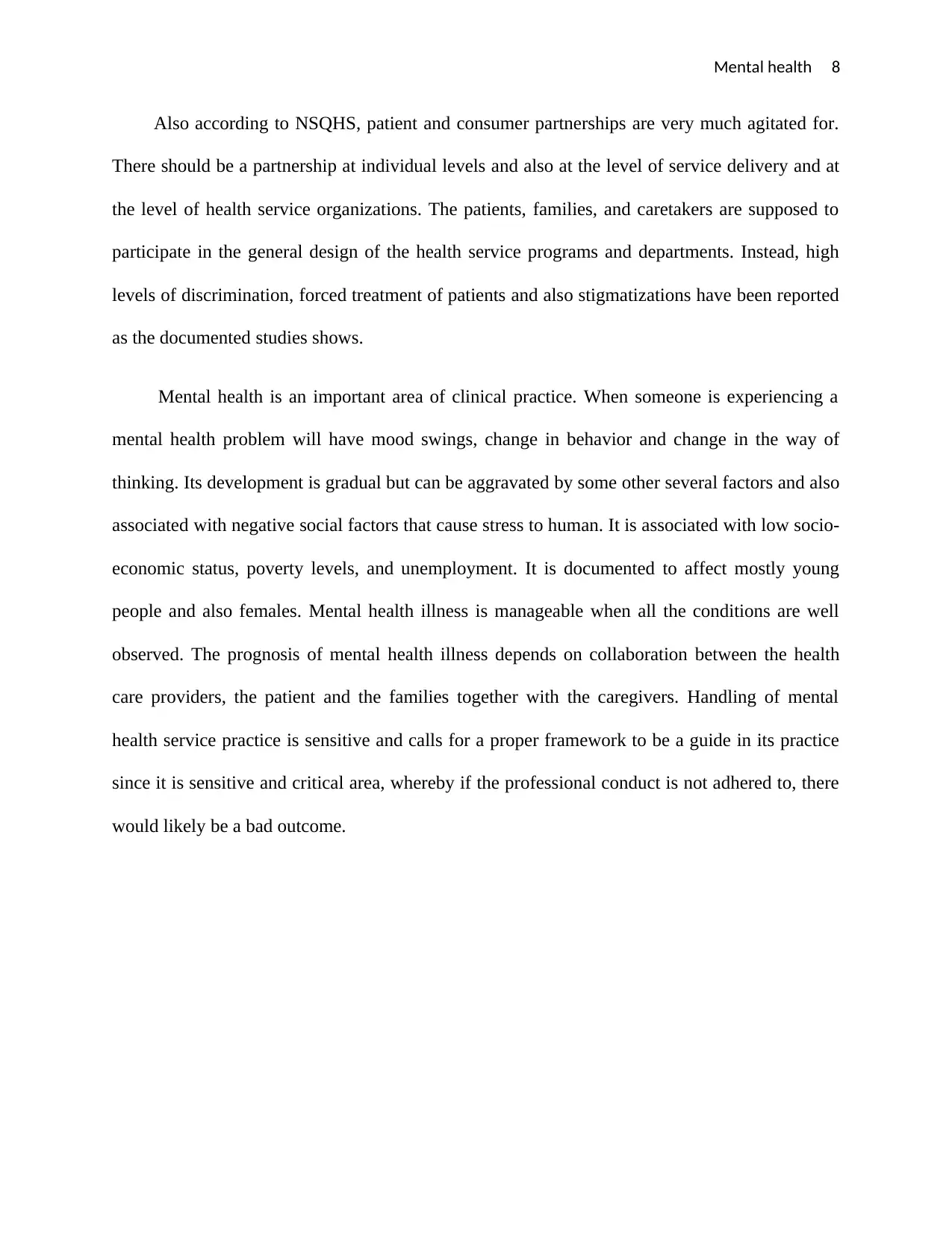
Mental health 8
Also according to NSQHS, patient and consumer partnerships are very much agitated for.
There should be a partnership at individual levels and also at the level of service delivery and at
the level of health service organizations. The patients, families, and caretakers are supposed to
participate in the general design of the health service programs and departments. Instead, high
levels of discrimination, forced treatment of patients and also stigmatizations have been reported
as the documented studies shows.
Mental health is an important area of clinical practice. When someone is experiencing a
mental health problem will have mood swings, change in behavior and change in the way of
thinking. Its development is gradual but can be aggravated by some other several factors and also
associated with negative social factors that cause stress to human. It is associated with low socio-
economic status, poverty levels, and unemployment. It is documented to affect mostly young
people and also females. Mental health illness is manageable when all the conditions are well
observed. The prognosis of mental health illness depends on collaboration between the health
care providers, the patient and the families together with the caregivers. Handling of mental
health service practice is sensitive and calls for a proper framework to be a guide in its practice
since it is sensitive and critical area, whereby if the professional conduct is not adhered to, there
would likely be a bad outcome.
Also according to NSQHS, patient and consumer partnerships are very much agitated for.
There should be a partnership at individual levels and also at the level of service delivery and at
the level of health service organizations. The patients, families, and caretakers are supposed to
participate in the general design of the health service programs and departments. Instead, high
levels of discrimination, forced treatment of patients and also stigmatizations have been reported
as the documented studies shows.
Mental health is an important area of clinical practice. When someone is experiencing a
mental health problem will have mood swings, change in behavior and change in the way of
thinking. Its development is gradual but can be aggravated by some other several factors and also
associated with negative social factors that cause stress to human. It is associated with low socio-
economic status, poverty levels, and unemployment. It is documented to affect mostly young
people and also females. Mental health illness is manageable when all the conditions are well
observed. The prognosis of mental health illness depends on collaboration between the health
care providers, the patient and the families together with the caregivers. Handling of mental
health service practice is sensitive and calls for a proper framework to be a guide in its practice
since it is sensitive and critical area, whereby if the professional conduct is not adhered to, there
would likely be a bad outcome.
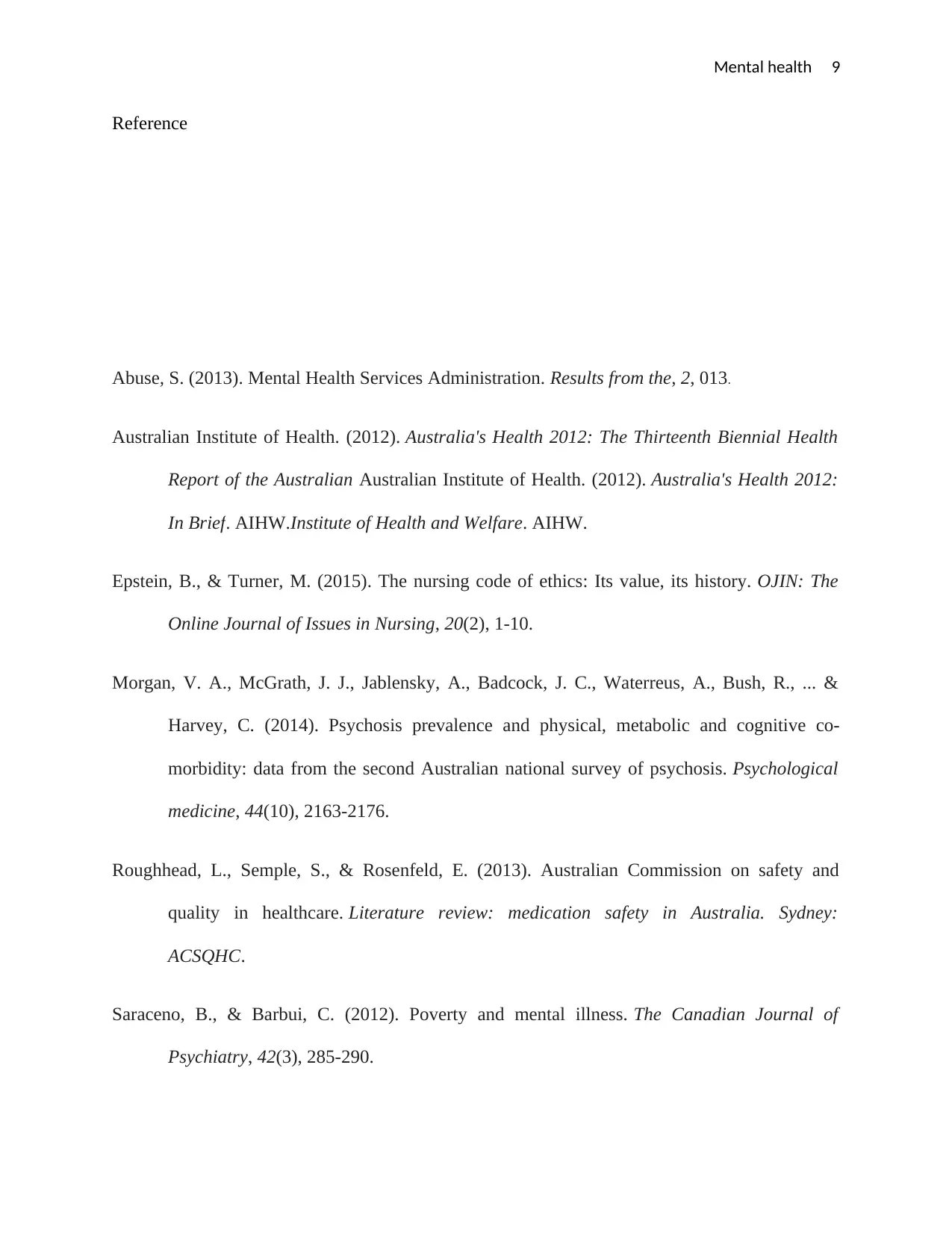
Mental health 9
Reference
Abuse, S. (2013). Mental Health Services Administration. Results from the, 2, 013.
Australian Institute of Health. (2012). Australia's Health 2012: The Thirteenth Biennial Health
Report of the Australian Australian Institute of Health. (2012). Australia's Health 2012:
In Brief. AIHW.Institute of Health and Welfare. AIHW.
Epstein, B., & Turner, M. (2015). The nursing code of ethics: Its value, its history. OJIN: The
Online Journal of Issues in Nursing, 20(2), 1-10.
Morgan, V. A., McGrath, J. J., Jablensky, A., Badcock, J. C., Waterreus, A., Bush, R., ... &
Harvey, C. (2014). Psychosis prevalence and physical, metabolic and cognitive co-
morbidity: data from the second Australian national survey of psychosis. Psychological
medicine, 44(10), 2163-2176.
Roughhead, L., Semple, S., & Rosenfeld, E. (2013). Australian Commission on safety and
quality in healthcare. Literature review: medication safety in Australia. Sydney:
ACSQHC.
Saraceno, B., & Barbui, C. (2012). Poverty and mental illness. The Canadian Journal of
Psychiatry, 42(3), 285-290.
Reference
Abuse, S. (2013). Mental Health Services Administration. Results from the, 2, 013.
Australian Institute of Health. (2012). Australia's Health 2012: The Thirteenth Biennial Health
Report of the Australian Australian Institute of Health. (2012). Australia's Health 2012:
In Brief. AIHW.Institute of Health and Welfare. AIHW.
Epstein, B., & Turner, M. (2015). The nursing code of ethics: Its value, its history. OJIN: The
Online Journal of Issues in Nursing, 20(2), 1-10.
Morgan, V. A., McGrath, J. J., Jablensky, A., Badcock, J. C., Waterreus, A., Bush, R., ... &
Harvey, C. (2014). Psychosis prevalence and physical, metabolic and cognitive co-
morbidity: data from the second Australian national survey of psychosis. Psychological
medicine, 44(10), 2163-2176.
Roughhead, L., Semple, S., & Rosenfeld, E. (2013). Australian Commission on safety and
quality in healthcare. Literature review: medication safety in Australia. Sydney:
ACSQHC.
Saraceno, B., & Barbui, C. (2012). Poverty and mental illness. The Canadian Journal of
Psychiatry, 42(3), 285-290.
⊘ This is a preview!⊘
Do you want full access?
Subscribe today to unlock all pages.

Trusted by 1+ million students worldwide
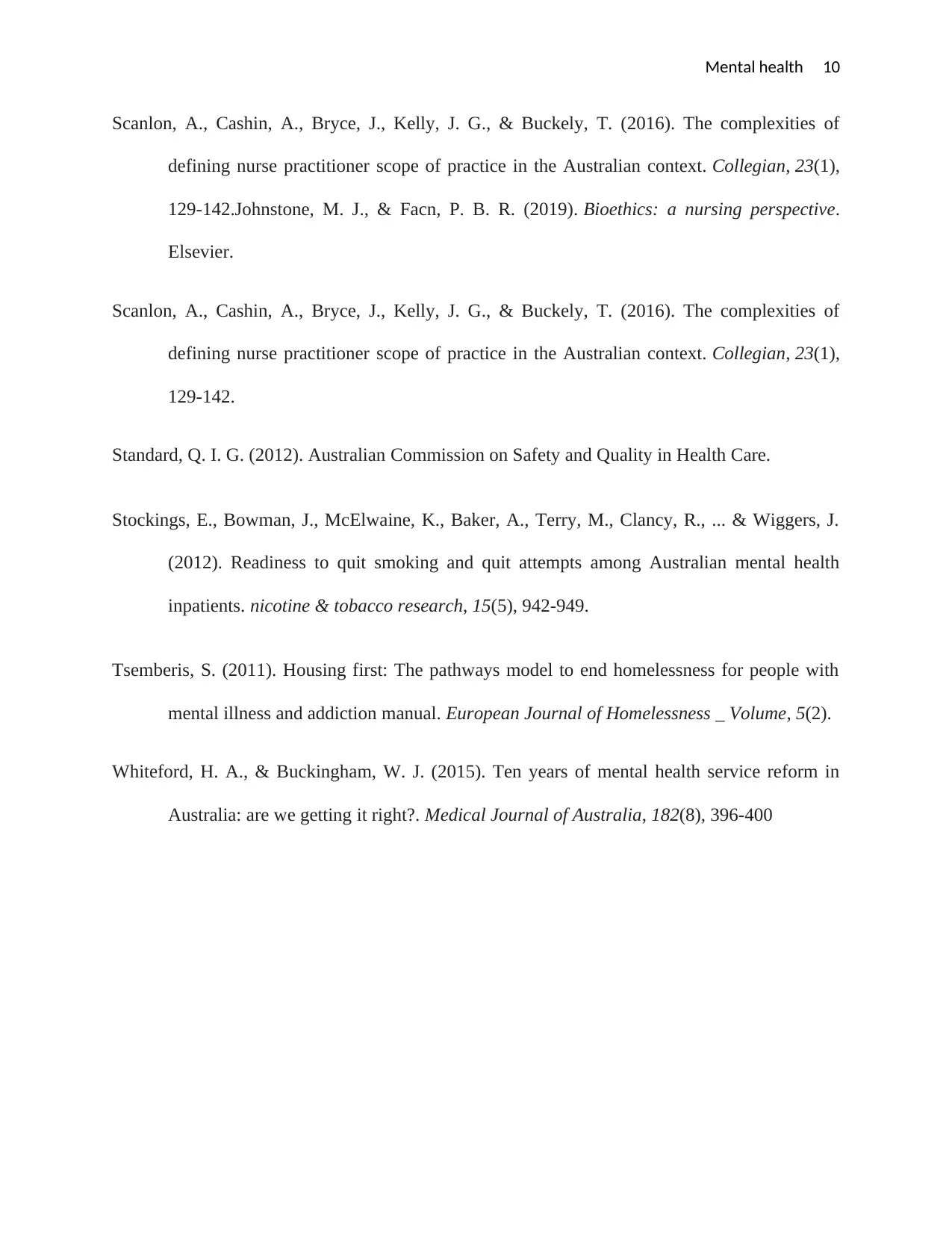
Mental health 10
Scanlon, A., Cashin, A., Bryce, J., Kelly, J. G., & Buckely, T. (2016). The complexities of
defining nurse practitioner scope of practice in the Australian context. Collegian, 23(1),
129-142.Johnstone, M. J., & Facn, P. B. R. (2019). Bioethics: a nursing perspective.
Elsevier.
Scanlon, A., Cashin, A., Bryce, J., Kelly, J. G., & Buckely, T. (2016). The complexities of
defining nurse practitioner scope of practice in the Australian context. Collegian, 23(1),
129-142.
Standard, Q. I. G. (2012). Australian Commission on Safety and Quality in Health Care.
Stockings, E., Bowman, J., McElwaine, K., Baker, A., Terry, M., Clancy, R., ... & Wiggers, J.
(2012). Readiness to quit smoking and quit attempts among Australian mental health
inpatients. nicotine & tobacco research, 15(5), 942-949.
Tsemberis, S. (2011). Housing first: The pathways model to end homelessness for people with
mental illness and addiction manual. European Journal of Homelessness _ Volume, 5(2).
Whiteford, H. A., & Buckingham, W. J. (2015). Ten years of mental health service reform in
Australia: are we getting it right?. Medical Journal of Australia, 182(8), 396-400
Scanlon, A., Cashin, A., Bryce, J., Kelly, J. G., & Buckely, T. (2016). The complexities of
defining nurse practitioner scope of practice in the Australian context. Collegian, 23(1),
129-142.Johnstone, M. J., & Facn, P. B. R. (2019). Bioethics: a nursing perspective.
Elsevier.
Scanlon, A., Cashin, A., Bryce, J., Kelly, J. G., & Buckely, T. (2016). The complexities of
defining nurse practitioner scope of practice in the Australian context. Collegian, 23(1),
129-142.
Standard, Q. I. G. (2012). Australian Commission on Safety and Quality in Health Care.
Stockings, E., Bowman, J., McElwaine, K., Baker, A., Terry, M., Clancy, R., ... & Wiggers, J.
(2012). Readiness to quit smoking and quit attempts among Australian mental health
inpatients. nicotine & tobacco research, 15(5), 942-949.
Tsemberis, S. (2011). Housing first: The pathways model to end homelessness for people with
mental illness and addiction manual. European Journal of Homelessness _ Volume, 5(2).
Whiteford, H. A., & Buckingham, W. J. (2015). Ten years of mental health service reform in
Australia: are we getting it right?. Medical Journal of Australia, 182(8), 396-400
1 out of 10
Related Documents
Your All-in-One AI-Powered Toolkit for Academic Success.
+13062052269
info@desklib.com
Available 24*7 on WhatsApp / Email
![[object Object]](/_next/static/media/star-bottom.7253800d.svg)
Unlock your academic potential
Copyright © 2020–2025 A2Z Services. All Rights Reserved. Developed and managed by ZUCOL.





